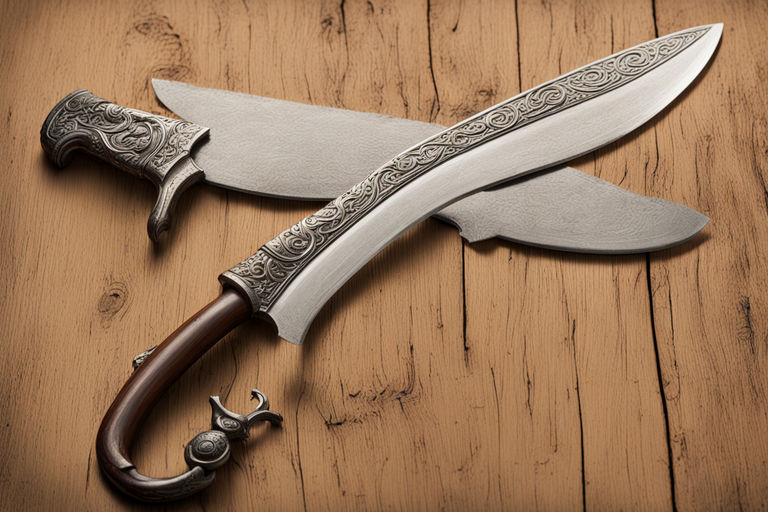Overview
Viking swords were surprisingly strong due to a combination of factors. Early swords made of low-carbon iron bent easily. Vikings then acquired higher quality blades through trade and used a technique called pattern welding to create swords that were both hard and flexible. Some exceptional swords, called Ulfberht, were made with crucible steel, a super strong technique. Beyond the metal itself, Vikings’ skill with their weapons and fearsome reputation also contributed to their success in battle.

Presently, here’s something very cool: those Viking swords were powerful and well-made, far better than you could naturally suspect! They weren’t simply common swords; they were like magic weapons that could bear stand up to a wide range of intense fights.
Thus, prepare to go along with us on an adventure as we dive into the past and reveal the mysteries of Viking swords. It will be an intriguing excursion loaded with shocks!
Imagine a time when Vikings roamed the lands with swords made of pure iron. But wait, there’s a catch! These swords were not as strong as they looked because they were made from low-carbon iron, which is not the toughest material. So, even though they were sharp, they weren’t very durable.
Now, picture a Viking warrior charging into battle with one of these swords. When the fighting got intense, these swords would often bend because they couldn’t handle the pressure. This made them less effective in a fight and sometimes even useless.
But fear not! Vikings were smart traders. They knew they needed better swords, so they traded with other cultures to get stronger blades made from higher quality materials. By doing this, they could have swords that wouldn’t bend so easily and would last longer in battles.
So, even though early Viking swords were made of pure iron, they had limitations. But through trade and acquisition, Vikings found ways to get better swords for their adventures!

Now, why go through all this trouble? Well, pattern welding made the sword super cool! It made the blade hard, so it could hold a sharp edge and cut through things easily. But at the same time, it made the sword flexible, so it could bend without breaking when it hit something hard. It’s like having a tough cookie that’s also bendy like a rubber band!
When archaeologists dig up old Viking swords and study them, they find evidence of pattern welding. They can see the different layers of metal all squished together. It’s like uncovering a secret recipe from the past!
So, thanks to pattern welding, Viking swords were both tough and flexible, making them perfect for battling through the ages!

Now, here comes the exciting part! These Ulfberht swords were made using a super advanced steel-making technique called crucible steel. It was like magic! Viking smiths, or maybe even others, would heat up different kinds of metals in a special container called a crucible. This made the steel super strong and extra sharp, perfect for slicing through enemies.
But hold onto your helmets! There’s a big debate about these swords. Some people think they were only made by Vikings because they were found in Viking areas. But others believe they might have been made by skilled smiths from other places too. It’s like trying to solve a mystery from the past!
So, the story of the Ulfberht swords is still being uncovered by historians and archaeologists. Who made them? Where did they come from? It’s a tale full of twists and turns that keeps us all guessing!

But it wasn’t just about the swords themselves. Vikings had a reputation that struck fear into the hearts of their opponents. Tales of their ferocity and bravery spread far and wide, making them seem almost unstoppable. This psychological factor might have given Vikings a benefit in the combat zone, as their enemies might have been threatened before the battle even started.
Thus, in Viking fighting, it wasn’t simply the swords that made a difference — it was likewise the expertise of the champions using them and the trepidation they imparted in their foes. This blend of actual ability and mental effect made Vikings an awe-inspiring phenomenon in fight.
Viking swords were strong because of multiple factors. First and foremost, they utilized a technique called pattern welding, where various metals were layered together and manufactured, making areas of strength for an adaptable cutting edge. Also, a few swords were made utilizing progressed cauldron steel, improving their strength and sharpness. Vikings additionally obtained high-quality blades through exchange with different societies, adding to their armory of impressive weapons.
The tradition of Viking swords endures today. Their inventive plans and master craftsmanship keep on motivating modern swordsmiths and historians alike. The iconic shape of Viking swords, with their particular grip and edge, stays an image of Viking society and military ability.
For those captivated by the stories of Viking swords and their wielders, investigating Viking history and weaponry further can be an exciting journey. Diving into the rich tapestry of Viking society offers experiences into their weapons, strategies, and the broader context of their era. Thus, snatch your safeguard and join the adventure into the intriguing universe of the Vikings!




